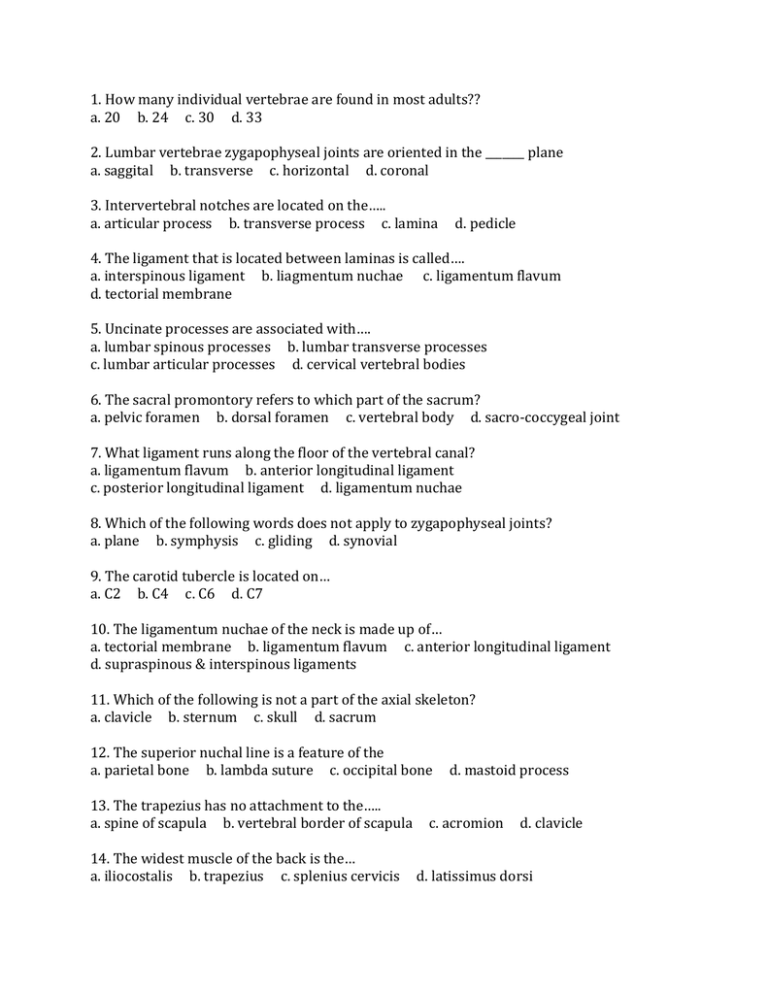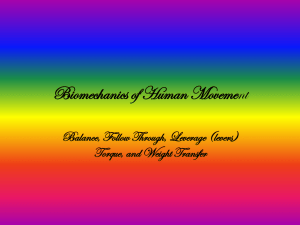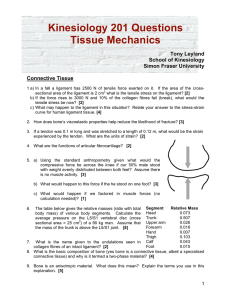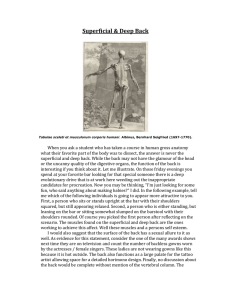practice exam 1 w_answers.doc
advertisement

1. How many individual vertebrae are found in most adults?? a. 20 b. 24 c. 30 d. 33 2. Lumbar vertebrae zygapophyseal joints are oriented in the _______ plane a. saggital b. transverse c. horizontal d. coronal 3. Intervertebral notches are located on the….. a. articular process b. transverse process c. lamina d. pedicle 4. The ligament that is located between laminas is called…. a. interspinous ligament b. liagmentum nuchae c. ligamentum flavum d. tectorial membrane 5. Uncinate processes are associated with…. a. lumbar spinous processes b. lumbar transverse processes c. lumbar articular processes d. cervical vertebral bodies 6. The sacral promontory refers to which part of the sacrum? a. pelvic foramen b. dorsal foramen c. vertebral body d. sacro-coccygeal joint 7. What ligament runs along the floor of the vertebral canal? a. ligamentum flavum b. anterior longitudinal ligament c. posterior longitudinal ligament d. ligamentum nuchae 8. Which of the following words does not apply to zygapophyseal joints? a. plane b. symphysis c. gliding d. synovial 9. The carotid tubercle is located on… a. C2 b. C4 c. C6 d. C7 10. The ligamentum nuchae of the neck is made up of… a. tectorial membrane b. ligamentum flavum c. anterior longitudinal ligament d. supraspinous & interspinous ligaments 11. Which of the following is not a part of the axial skeleton? a. clavicle b. sternum c. skull d. sacrum 12. The superior nuchal line is a feature of the a. parietal bone b. lambda suture c. occipital bone 13. The trapezius has no attachment to the….. a. spine of scapula b. vertebral border of scapula 14. The widest muscle of the back is the… a. iliocostalis b. trapezius c. splenius cervicis d. mastoid process c. acromion d. clavicle d. latissimus dorsi 15. Ipsilateral rotation of the spine is a function of a. erector spinae b. latissimus dorsi c. semispinalis thoracis d. rotators 16. Spinal level C8 contributes to the nerve supply to which muscle? a. levator scapulae b. deltoid c. trapezius d. latissimus dorsi 17. Ipsilateral rotation of the head on the neck is a function of a. rectus minor b. rhomboid minor c. superior oblique d. inferior oblique 18. The floor of the suboccipital triangle is made up of the a. tectorial membrane b. alar ligament c. cruciform ligament d. posterior atlanto-occipital membrane 19. Sensory supply to the back of the head is a function of a. spinal accessory nerve b. suboccipital nerve c. greater occipitial nerve d. thoracodorsal nerve 20. The vertebral artery is a branch of the a. occipital artery b. subclavian artery c. thyrocervical trunk d. external carotid artery 21. What muscle attaches to the posterior tubercle of the atlas? a. rectus minor b. rectus major c. semispinalis cervicis d. trapezius 22. The lumbar cistern is filled with a. blood b. perilymph c. cerebrospinal fluid d. urine 23. Which of the following has only sensory function? a. dorsal root of spinal nerve b. ventral root of spinal nerve c. dorsal primary ramus of spinal nerve b. ventral primary ramus of spinal nerve 24. What meningeal layer is continuous with the epineurium? a. posterior longitudinal ligament b. pia mater c. arachnoid d. dura mater 25. The dural sac ends at bony level… a. L2 b. L5 c. S2 d. S5 26. The notocord first appears on embryonic day… a. 4 b. 7 c. 15 d. 21 27. Which of the following belongs in the list of muscles that attaches the humerus to the pectoral girdle? a. trapezius b. latissimus dorsi c. infraspinatus d. rhomboid major 28. Which muscle attaches to the medial edge of the intertubercular sulcus? a. latissimus dorsi b. teres major c. pectoralis major d. long head of biceps 29. The inferior end of the scapula is the landmark for locating a. xiphoid process b. coracoid process c. rib 12 d. rib 7 30. Lateral (external) rotation of the humerus is a function of a. latissimus dorsi b. teres minor c. teres major d. subscapularis 31. The suprascapular artery is a branch of the a. thyrocervical trunk b. external carotid artery d. thoracodorsal artery c. axillary artery 32. The lateral border of the quadrangular space is the a. spiral groove b. surgical neck of the humerus c. long head of triceps d. lateral head of triceps 33. The subacromial/subdeltoid bursa overlies the tendon of a. supraspinatus b. deltoid c. trapezius d. teres major 34. The sternoclavicular joint is classified as what type of joint? a. symphysis b. plane c. saddle d. pivot 35. The coracoclavicular ligaments stablize which joint? a. sternoclavicular b. acromioclavicular c. glenohumeral d. zygapophyseal Clinical question In order to win points with his new girlfriend, our aging baby-boomer friend took her teenagers to the carnival and decided to impress them with his driving skills in the bumper car ride. Well, none of them were even remotely impressed and they began to bump his car. One well-placed bump caused his head to whiplash, 911 was called, he had to be immobilized and carried off on a stretcher. Xrays showed that the intervertebral disk between C4 and C5 was completely herniated on the right side - the vertebral bodies were touching. 36. Which spinal nerve would be affected with this injury? a. C3 b. C4 c. C5 d. C6 37. What nerve would not be affected with an injury like this? a. dorsal scapular b. upper subscapular c. axillary d. thoracodorsal 38. The function of which of the following muscles would be affected by this injury? a. trapezius b. deltoid c. latissimus dorsi d. rectus major 39. What is the outermost layer of the intervertebral disk? a. tectorial membrane b. annulus fibrosis c. nucleus pulposis d. nuchal membrane 40. A more severe whiplash injury would affect C1 and C2. With hyper-extension of the head at the neck, the dens could fracture. What ligament forms the socket for the dens? a. apical ligament b. alar ligament c. tectorial membrane d. cruciform ligament As he was recovering, he decided to try another way to impress the teenagers, and took them to the roller rink so they could roller skate together. Unfortunately, he didn’t know that the daughters played roller derby and the sons played roller hockey - they skated circles around him. While he was doing some of his best roller skate dance moves he slipped and fell against the board and hurt his shoulder. It looked like there was a finger pointing underneath his skin at the end of his shoulder. 41. What injury is this? a. shoulder separation b. shoulder dislocation c. fracture of surgical neck d. fracture of midshaft of humerus 42. What ligament is the strongest to prevent this injury? a. sternoclavicular b. glenohumeral c. acromioclavicular d. coracoclavicular 43. What bony feature causes the appearance of a pointing finger? a. greater tubercle b. acromion c. acromial end of clavicle d. sternal end of clavicle 44. This injury affects the attachment of which muscle? a. supraspinatus b. deltoid c. subscapularis d. latissimus dorsi 45 - 50 - matching 45. rhomboid major 46. trapezius 47. supraspinatus 48. teres major 49. latissimus dorsi 50. splenius capitis a. extension of the arm at the shoulder b. ipsilateral rotation of the head c. supplied by a cranial nerve d. downward rotation of the scapula e. supplied by C5-7 f. abduction at the shoulder ANSWERS TO PRACTICE EXAM 1 FALL 2013 1. 2. 3. 4. 5. 6. 7. 8. 9. 10. 11. 12. 13. 14. 15. 16. 17. 18. 19. 20. 21. 22. 23. 24. 25. 26. 27. 28. 29. 30. 31. 32. 33. 34. 35. 36. 37. 38. 39. 40. B A D C D C C B C D A C B D A D D D C B A C A D C C C B D B A B A C B C D C B D 41. 42. 43. 44. 45. 46. 47. 48. 49. 50. A D C B D C F E A B





